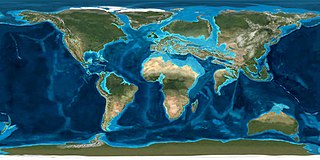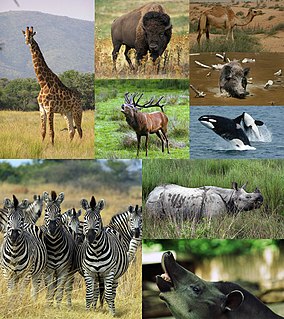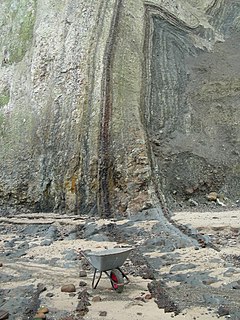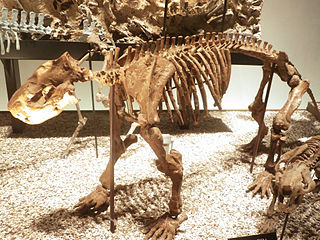
The Cenozoic is Earth's current geological era, representing the last 66 million years of Earth's history. It is characterized by the dominance of mammals, birds and flowering plants, a cooling and drying climate, and the current configuration of continents. It is the latest of three geological eras since complex life evolved, preceded by the Mesozoic and Paleozoic. It started with the Cretaceous–Paleogene extinction event, when many species, including the non-avian dinosaurs, became extinct in an event attributed by most experts to the impact of a large asteroid or other celestial body, the Chicxulub impactor.

The Eocene Epoch is a geological epoch that lasted from about 56 to 33.9 million years ago (mya). It is the second epoch of the Paleogene Period in the modern Cenozoic Era. The name Eocene comes from the Ancient Greek ἠώς and καινός and refers to the "dawn" of modern ('new') fauna that appeared during the epoch.

The Paleogene is a geologic period and system that spans 43 million years from the end of the Cretaceous Period 66 million years ago (Mya) to the beginning of the Neogene Period 23.03 Mya. It is the beginning of the Cenozoic Era of the present Phanerozoic Eon. The earlier term Tertiary Period was used to define the span of time now covered by the Paleogene and subsequent Neogene periods; despite no longer being recognised as a formal stratigraphic term, 'Tertiary' is still widely found in earth science literature and remains in informal use. The Paleogene is most notable for being the time during which mammals diversified from relatively small, simple forms into a large group of diverse animals in the wake of the Cretaceous–Paleogene extinction event that ended the preceding Cretaceous Period. The United States Geological Survey uses the abbreviation PE for the Paleogene, but the more commonly used abbreviation is PG with PE being used for Paleocene, an epoch within the Paleogene.

Ungulates are members of the diverse clade Ungulata which primarily consists of large mammals with hooves. These include odd-toed ungulates such as horses, rhinoceroses, and tapirs; and even-toed ungulates such as cattle, pigs, giraffes, camels, sheep, deer, and hippopotamuses. Cetaceans such as whales, dolphins, and porpoises are also classified as even-toed ungulates, although they do not have hooves. Most terrestrial ungulates use the hoofed tips of their toes to support their body weight while standing or moving.

Podocnemididae is a family of pleurodire (side-necked) turtles native to Madagascar and northern South America, though they were more widely distributed in the past. Podocnemidid turtles are commonly called "side-necked turtles" in direct reference to their inability to retract their heads backwards, but hide them sideways. In addition, their pelvis is fused to the shell which prevents any pelvic motion. Due to their pelvis being immobile they are unable to walk on land, which requires greater pelvis mobility. For this reason, Podocnemididae turtles are best suited for swimming and as a result live in aquatic environments. These turtles are all aquatic, inhabiting streams and other flowing water. Their shells are streamlined to aid in swimming.
The Thanetian is, in the ICS Geologic timescale, the latest age or uppermost stratigraphic stage of the Paleocene Epoch or series. It spans the time between 59.2 and56 Ma. The Thanetian is preceded by the Selandian age and followed by the Ypresian age. The Thanetian is sometimes referred to as the Late Paleocene.

Protungulatum is a extinct genus of pan-euungulate mammals within extinct family Protungulatidae, and also one of the earliest known placental mammal in the fossil record, that lived in North America from the Late Cretaceous to early Paleocene.

The Fur Formation is a marine geological formation of Ypresian age which crops out in the Limfjord region of Denmark from Silstrup via Mors and Fur to Ertebølle, and can be seen in many cliffs and quarries in the area. The Diatomite Cliffs is on the Danish list of tentative candidates for World Heritage and may become a world Heritage site.

Bothremydidae is an extinct family of side-necked turtles (Pleurodira) known from the Cretaceous and Cenozoic. They are closely related to Podocnemididae, and are amongst the most widely distributed pleurodire groups, with their fossils having been found in Africa, India, the Middle East, Europe, North America and South America. Bothremydids were aquatic turtles with a high morphological diversity, indicative of generalist, molluscivorous, and piscivorous diets. Unlike modern pleurodires, which are exclusively freshwater, bothremydids inhabited freshwater, marine and coastal settings. Their marine habits allowed bothremydids to disperse across oceanic barriers into Europe and North America during the early Late Cretaceous (Cenomanian). The youngest records of the group are indeterminate remains from Saudi Arabia and Oman, dating to the Miocene.

Herpetotheriidae is an extinct family of metatherians. Although sometimes placed in the living opossum family, they may form the sister clade to all living marsupials. Species of this family are generally reconstructed as terrestrial. Fossils of herpetotheriids come from North America, Asia, Europe, Africa, and perhaps South America. The oldest representative is Maastrichtidelphys from the latest Cretaceous (Maastrichtian) of the Netherlands and the youngest member is Amphiperatherium from the Middle Miocene of Europe.
The Paleocene, or Palaeocene, is a geological epoch that lasted from about 66 to 56 million years ago (mya). It is the first epoch of the Paleogene Period in the modern Cenozoic Era. The name is a combination of the Ancient Greek παλαιός palaiós meaning "old" and the Eocene Epoch, translating to "the old part of the Eocene".

Tillodontia is an extinct suborder of eutherian mammals known from the Early Paleocene to Late Eocene of China, the Late Paleocene to Middle Eocene of North America where they display their maximum species diversity, the Middle Eocene of Pakistan, and the Early Eocene of Europe. Leaving no descendants, they are most closely related to the pantodonts, another extinct group. The tillodonts were medium- to large-sized animals that probably feed on roots and tubers in temperate to subtropical habitats.

The Itaboraian age is a period within the Early Eocene geologic time epoch of the Paleogene, used more specifically with South American land mammal ages (SALMA). It follows the Riochican and precedes the Casamayoran age.

Palaeonictis is an extinct predatory mammal belonging to the family Oxyaenidae, existing from the late Paleocene to the early Eocene in Europe and North America.

Meretrix is a genus of edible saltwater clams, marine bivalve molluscs in the family Veneridae, the Venus clams. They appeared in the fossil record in the Cenomanian age.

The Willwood Formation is a sedimentary sequence deposited during the late Paleocene to early Eocene, or Clarkforkian, Wasatchian and Bridgerian in the NALMA classification.

Bemalambdidae is an extinct family of pantodont mammals known from Early and Middle Paleocene of China.

The Oulad Abdoun Basin is a phosphate sedimentary basin located in Morocco, near the city of Khouribga. It is the largest in Morocco, comprising 44% of Morocco's phosphate reserves, and at least 26.8 billion tons of phosphate. It is also known as an important site for vertebrate fossils, with deposits ranging from the Late Cretaceous (Cenomanian-Turonian) to the Eocene epoch (Ypresian), a period of about 25 million years.
Wyonycteris is a genus of small mammals that existed in the late Paleocene and early Eocene epochs. The type species is Wyonycteris chalix, which lived in Wyoming during the Clarkforkian North American Land Mammal Age of the Paleocene and was originally proposed to be an early form of insectivorous bat. Later re-examination of the material has put this alliance in doubt, and the genus has instead been proposed as belonging to the subfamily Placentidentinae, within the family Nyctitheriidae. Similar fossil material of the same time period found in Europe was later discovered and described as new species, Wyonycteris richardi.

The Itaboraí Formation is a highly fossiliferous geologic formation and Lagerstätte of the Itaboraí Basin in Rio de Janeiro, southeastern Brazil. The formation reaching a thickness of 100 metres (330 ft) is the defining unit for the Itaboraian South American land mammal age (SALMA), dating to the Early Eocene, approximately 53 to 50 Ma.

















